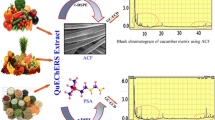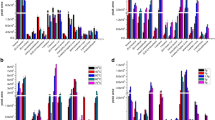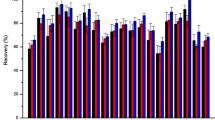Abstract
The feasibility of circulating cooling-solid phase microextraction (CC-SPME) combined with gas chromatography-nitrogen phosphorous detector (GC-NPD) for the determination of five organophosphorous pesticides (OPPs) in tomato samples is evaluated. By heating the sample while cooling the fiber coating, the developed method provides better performance in terms of sensitivity, linearity and recovery than that of traditional headspace-solid phase microextraction (HS-SPME). The extraction capacities of activated carbon fiber (ACF) and three commercially available fibers were compared. ACF is found to be the most suitable fiber for the analysis of OPPs in tomatoes. The main factors affecting the CC-SPME process such as adsorption time, adsorption temperature and ionic strength were investigated and optimized. The matrix effect was evaluated, and concluded that addition of water is required to reduce the matrix effect. Good linearity (R 2 > 0.992) is observed in the 1–200 ng g−1 concentration range with satisfactory RSD (%) values of 5.6–8.5%. The limits of detection obtained using the proposed method range from 0.2 to 0.5 ng g−1, and the recoveries for CC-SPME are in the range of 82.5–90.0% with RSDs lower than 8.7%. Experimental results confirm the usefulness of the proposed method for the analysis of OPPs in tomato samples.



Similar content being viewed by others
References
Sogorb MA, Vilanova E (2002) Toxicol Lett 128:215–228
Brito NM, Navickiene S, Polese L, Jardim EFG, Abakerli RB, Ribeiro ML (2002) J Chromatogr A 957:201–209
Norman KNT, Panton SHW (2001) J Chromatogr A 907:247–255
Rissato SR, Galhiane MS, Knoll FRN, Apon BM (2004) J Chromatogr A 1048:153–159
Zhu X, Yang J, Su Q, Cai J, Gao Y (2005) J Chromatogr A 1092:161–169
Moullec SL, Begos A, Pichon V, Bellier B (2006) J Chromatogr A 1108:7–13
Ballesteros E, Parrado MJ (2004) J Chromatogr A 1029:267–273
Arthur CL, Pawliszyn J (1990) Anal Chem 62:2145–2148
Bouaid A, Ramos L, Gonzalez MJ, Fernández P, Cámara C (2001) J Chromatogr A 939:13–21
Mestres M, Busto O, Guasch J (2002) J Chromatogr A 945:211–219
Doong R-A, Liao P-L (2001) J Chromatogr A 918:177–188
Lambropoulou DA, Albanis TA (2002) J Agric Food Chem 50:3359–3365
Tsoutsi C, Konstantinou I, Hela D, Albanis T (2006) Anal Chim Acta 573–574:216–222
Cai L, Gong S, Chen M, Wu C (2006) Anal Chim Acta 559:89–96
Ng WF, Teo MJK, Lakso H-Å (1999) Fresenius J Anal Chem 363:673–679
Liao L, Yang J, Wang Y, Sun T, Jia J (2006) J Chromatogr A 1135:1–5
Sun T, Jia J, Fang N, Wang Y (2005) Anal Chim Acta 530:33–40
Sun T, Cao L, Jia J (2005) Chromatographia 61:173–179
Valor I, Moltó JC, Apraiz D, Font G (1997) J chromatogr A 767:195–203
Ai J (1997) Anal Chem 69:1230–1236
Simplicio AL, Boas LV (1999) J Chromatogr A 833:35–42
Acknowledgments
We acknowledge the financial support for the research from the National High Technology Research and Development Project (2006AA09Z172).
Author information
Authors and Affiliations
Corresponding author
Rights and permissions
About this article
Cite this article
Chai, X., Jia, J., Sun, T. et al. Suitability of a Novel Circulating Cooling SPME for Analysis of Organophosphorous Pesticides in Tomatoes. Chroma 67, 309–313 (2008). https://doi.org/10.1365/s10337-007-0486-1
Received:
Revised:
Accepted:
Published:
Issue Date:
DOI: https://doi.org/10.1365/s10337-007-0486-1




